Subtropical Deserts are the Sahara Desert, Arabian Desert, Kalahari Desert, Mojave Desert, Sonoran Desert, Chihuahuan, Australian Deserts, Sandy and Victoria Desert. All are the Most important world deserts.
Subtropical Deserts of the World
Subtropical desert locales are responsible for a huge segment of people arriving on this planet. These locales are characterized, for the most part, by warm to extremely hot temperatures with cooler winters.
The temperature, for the most part, generally changes simply over the span of a day, moving from hotter to cooler in a matter of hours. These deserts have a tendency to have not very many plants and creatures., and those that remain have adjusted to the course, dry soil and the ever-display wind.
1. Sahara Desert

- Of all the deserts in the world, the Sahara Desert is the biggest and falls into a subtropical desert atmosphere. The Sahara covers the majority of northeastern Africa, which is around 10% of the mainland. It is about as substantial as the United States as far as land territory is concerned.
- It can take upwards of seven days to cross this desert via auto and over 40 days of strolling! In spite of the fact that the Sahara is extensive, it is, in fact, the third-biggest desert after Antarctica and the Arctic. The Sahara stretches from the Atlantic Ocean in the west to the Mediterranean in the north to the Red Sea in the east. Ten nations in Africa have some piece of their country in the Sahara Desert.
- The Sahara has a portion of the most significant sand dunes on the planet. Some can reach about 600 feet (183 metres) tall. Even though motion picture creations may have persuaded us generally, just a single-fourth of the Sahara territory contains sand ridges.
- The average temperature in the Sahara is an agreeable 86°F (29°C); however, it can reach as high as 120°F (49°C) in the hottest parts of the year. If that isn’t sufficiently hot for you, the record temperature was accounted for at a hot 136°F (58°C)!
2. Arabian Desert

The Arabian Desert is named after its area as it makes up the more significant part of the Arabian Peninsula, which incorporates the nations of Qatar, Yemen, Oman, United Arab Emirates, Kuwait, and Saudi Arabia. In the focal point of the Arabian Desert, you will locate Earth’s most significant region of solid sand called Rub’al-Khali.
It additionally incorporates characteristic events of the infamous and deadly “sand trap.” The Arabian Desert outskirts the Nile River Valley on its west side and the Gulf of Suez on the eastern end, which makes it encompassed by water on all sides except for the upper east corner that associates it with the Asian landmass.
3. Kalahari Desert
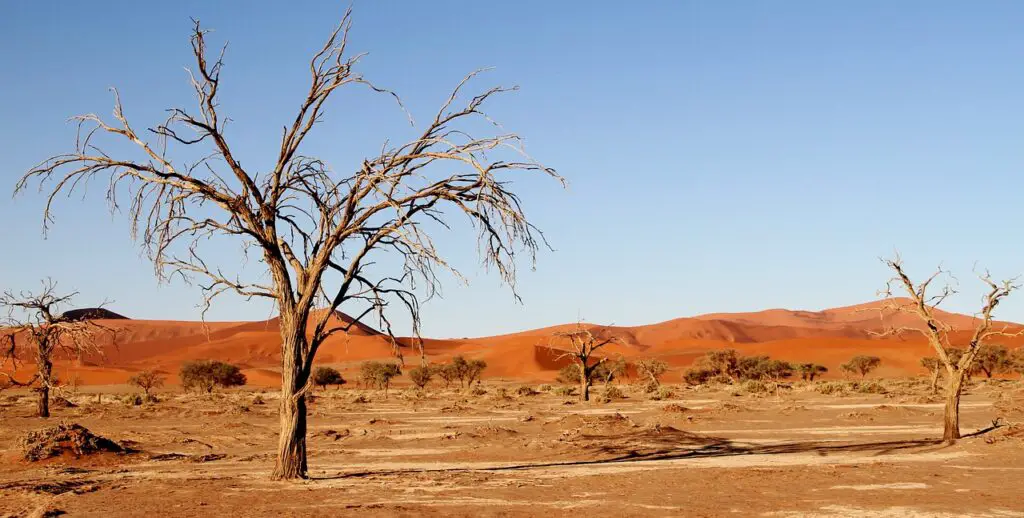
The Kalahari Desert is extraordinary among the subtropical deserts. Get essentially has more precipitation and bolster more different life than its partners. About twofold the rain (5-9 inches every year) of the Arabian and Sahara Desert, yet parts of the Kalahari still meet the meaning of a desert regarding rainfall.
It covers the vast majority of the African countries of Namibia, Botswana, and bits of South Africa. The Kalahari is roughly 600 miles (966 km) wide and 1,000 miles (1,609 km) from north to south. Inside the Kalahari Desert, you will locate the Central Kalahari Game Reserve – the second biggest ensured territory for untamed life on the planet.
4. Mojave Desert
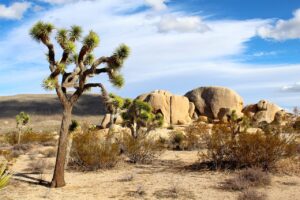
The Mojave Desert can be found in the southwestern United States, covering bits of southern Nevada and southeastern California. The Mojave Desert contains the notorious Death Valley, known for being the most reduced point, driest area, and most sultry territory on the North American landmass.
The climate there is portrayed by outrageous warmth and chilly. It can dip under solidifying and surpass 75°F (23°C) in a solitary day. The record high for the Mojave is 134°F (57°C). The record cool temperature came to be 15°F (- 10°C)!
5. Sonoran Desert

The Sonoran Desert is situated in the southwestern piece of the United States, venturing into northwestern Mexico. It is the most sultry desert in the North American landmass, with air temperatures reliably transcending 118°F (48°C). The Sonoran Desert is a tremendous field of more than 100,000 square miles (259,000 square km) the region.
It likewise happens to have an amazingly differing lineup of natural life. There are more than 65 warm-blooded animals, 340 feathered creatures, 100 reptiles, and 2,500 types of plants over the locale. The Sonoran Desert is the main place on the planet you can discover a normally happening Saguaro Cacti, which can live for more than 200 years!
6. Chihuahuan Desert
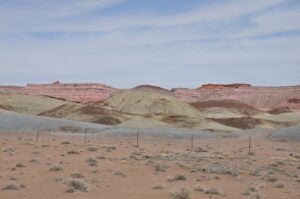
The Chihuahuan Desert is the biggest desert in the North American mainland. More than 390,000 square miles it has a land zone (1,010,095 square km) over Northern Mexico (70%) and the southern United States (30%).
The Chihuahuan Desert ventures into New Mexico, Texas and Arizona in the US and Chihuahua, Durango, Coahuila, Zacatecas, and Nuevo Leon in Mexico, which represents around 1.5% of the land zone on the North American landmass.
It is viewed as a “rain shadow desert,” which implies that mountains that lay on the edges of the desert square a great part of the precipitation from entering. This region is eminent for its highly assorted variety of prickly plants, with more than 300 species found inside its limits.
7. Thar Desert
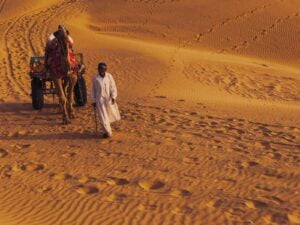
The Thar Desert is otherwise called the Great Indian Desert and lies in the northwestern piece of India – prevalently in the Royal Rajasthan states. It is the seventh biggest sub-tropical desert and the most meagerly populated district in India. All things being equal, the Thar Desert is the most thickly populated desert on the planet.
In view of the expansion in the populace in the zone, the Thar Desert is home to a progression of celebrations consistently which are commended with music and movement. The desert is interestingly home to five saltwater lakes that stamp the scene.
8. Australian Desert

Australia is home to an extensive variety of desert regions because of its interesting topographical highlights and atmosphere. 66% of the Australian mainland is viewed as parched or desert, which makes the landmass the driest on Earth after Antarctica.
When you consider every one of the deserts of the world, Australia does not have the biggest desert territories, but rather they do have the most desert regions of any landmass when contrasted with the aggregate mainland surface region.
There are 10 distinct deserts on the mainland of Australia. Numerous are bordering, and some even cover. They incorporate the Great Victoria Desert, Great Sandy Desert, Tanami Desert, Simpson Desert, Gibson Desert, Little Sandy Desert, Strzelecki Desert, Sturt Stony Desert, Tirari Desert, and Pedirka Desert.
9. Great Sandy Desert
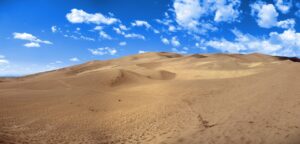
The second biggest desert in Australia is The Great Sandy Desert. It is mainly situated in the northern area of Western Australia. The Great Sandy Desert is home to the Kata Tjuta – Uluru, also called Ayers – a world legacy site. Ayers Rock is a colossal sandstone arrangement that broadens unexplainably from the level desert to a mountain level that achieves 1,150 feet (350 m) into the sky.
There are additionally some exceptionally one-of-a-kind plants in the Great Sandy Desert, including the Desert Bloodwood – an average size tree that has blood-like sap and rugged clear out. Be that as it may, it has not generally been awesome for natural life in this desert.
At the time, it was the longest fence on the planet, and parts of the fence are as yet noticeable today.
10. Great Victoria Desert

Australia’s biggest desert is The Great Victoria Desert, and the third biggest sub-tropical desert on the planet after the Sahara and Arabian. It is one of the minimum populated territories in the southwestern piece of Australia.
Encompassed by the Gibson Desert toward the North, The Great Victorian Desert is the Little Sandy Desert toward the northwest, the Simpson and Sturt Stony Desert toward the east, and fields toward the south.
The Great Victorian Desert does not look like what numerous consider a desert. It qualifies because of an absence of precipitation, yet you won’t discover interminable sand ridges or infertile fields there. There is a lot of vegetation and natural life displayed in the Great Victorian Desert, which is the thing that makes it such a went by area for voyagers.

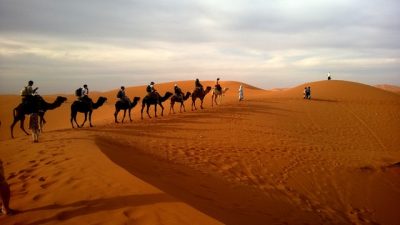


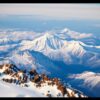





There is certainly a lot to know about this topic. I like all of the points you have made.
Pretty section of content. I just stumbled upon your web site and in accession capital to assert that I get actually enjoyed account your blog posts. Any way I’ll be subscribing to your feeds and even I achievement you access consistently quickly.
Very nice article, totally what I was looking for.
Way cool! Some extremely valid points! I appreciate you penning this write-up and also the rest of the website is very good.